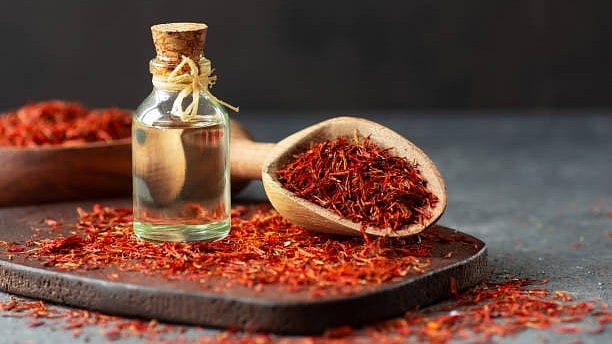
Representative image of saffron.
Credit: iStock Photo
Srinagar: The dream of a bumper saffron harvest has withered once again in Kashmir’s famed saffron belt, as farmers report a drastic decline in flowering - a lingering aftereffect of consecutive heat-waves that have weakened the region’s delicate crop and its once-fertile soil.
Despite timely rains and favourable early sowing conditions, the bloom this year is estimated at only 15 to 20 per cent of normal levels, according to Abdul Majeed Wani, President of the Kashmir Saffron Growers Association.
“Last year’s intense heat damaged the corms underground, and the plants could not recover even after this year’s good rainfall,” Wani said. “The bloom is much lower than what we had hoped for. Many farmers are disappointed because they were expecting a rebound after two difficult years.”
Saffron, known as kong in Kashmiri, zaffran in Urdu, and kesar in Hindi, comes from the crimson filament-like parts of the flower, called the stigma and is used in cooking, skincare, perfumery, textile dyes, and medicine.
Farmers across Pampore, Khrew, and Lethpora - the traditional saffron-growing areas of south Kashmir - say their fields look lush but have yielded few flowers. “Our fields look healthy, but the flowers are missing,” said Javeed Kuchay, a grower from Pampore. “We irrigated properly and even used organic manure, but nature had other plans.”
Another grower, Bilal Ahmad from Khrew, said the prolonged dry spells and extreme summer temperatures have altered the soil’s natural rhythm. “The saffron corms need moisture during the summer and cold nights in autumn. Last year’s heat wave upset the entire cycle. We are seeing the effects now,” he said.
Kashmir’s saffron - known globally for its deep red stigma and strong aroma - has been cultivated for centuries in the Pampore plateau, earning the region the title “Saffron Town”. But in recent years, the crop has become increasingly vulnerable to erratic weather, shrinking acreage, and declining soil health.
Once spread over 5,707 hectares, saffron cultivation has dropped sharply to 3,665 hectares due to both climate pressures and urban expansion. The Central government’s National Saffron Mission, launched in 2010 to revive the sector through better irrigation and scientific techniques, initially improved yields - but the gains have since stalled.
Scientists attribute the latest decline to rising summer temperatures, which deplete soil moisture and damage the corms - the underground bulbs from which saffron flowers emerge.
“Saffron requires a precise balance - hot, dry summers but not scorching ones, and cool, moist autumns for flowering,” said an official from the Agriculture Department. “Heatwaves over the past two years have disrupted that balance.”
For thousands of families in Pampore, saffron is more than a crop — it is a heritage and a livelihood. But as climate change intensifies, the future of Kashmir’s “red gold” looks increasingly uncertain.
Experts warn that unless sustained soil rejuvenation and micro-irrigation measures are expanded, the decline could become irreversible. “The saffron fields are an early warning sign of what climate stress can do to high-value traditional crops,” said an agriculture scientist at SKUAST-Kashmir.